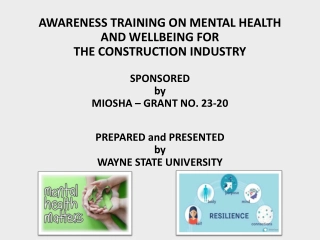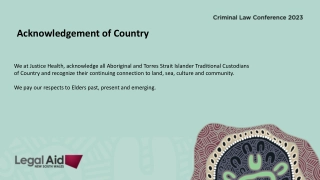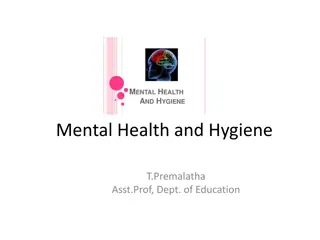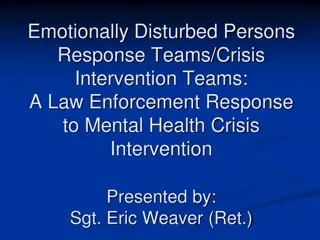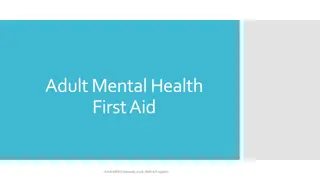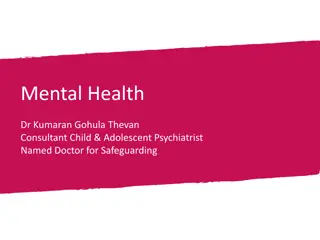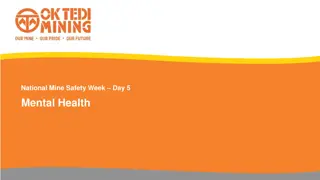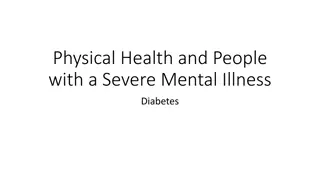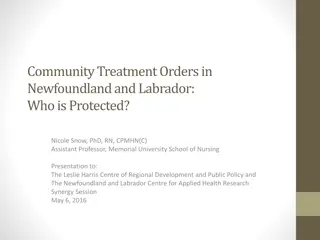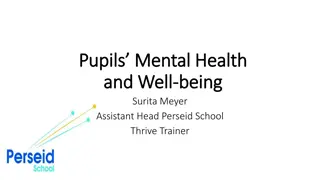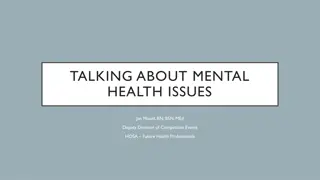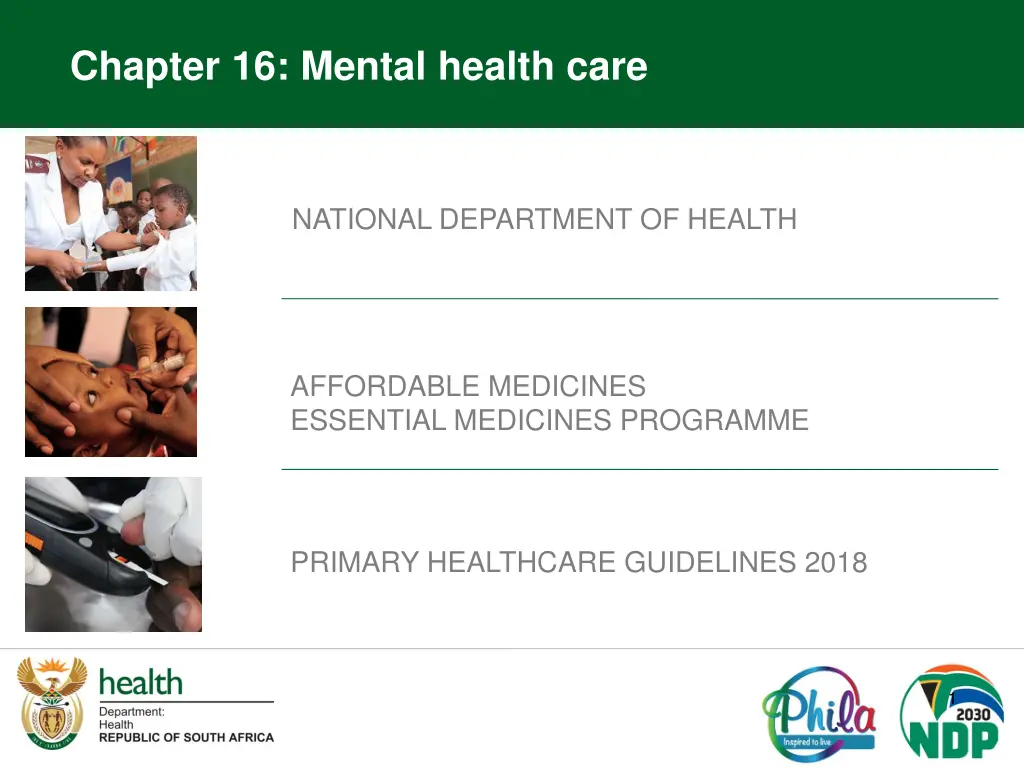
Effective Management Strategies for Anxiety and Depression
Explore evidence-based approaches for managing anxiety and depression, including psychotherapy, medication options like fluoxetine and SSRIs, and dosing considerations. Learn about the symptoms, changes in treatment guidelines, and reasons behind the recommended interventions to enhance mental health care.
Download Presentation

Please find below an Image/Link to download the presentation.
The content on the website is provided AS IS for your information and personal use only. It may not be sold, licensed, or shared on other websites without obtaining consent from the author. If you encounter any issues during the download, it is possible that the publisher has removed the file from their server.
You are allowed to download the files provided on this website for personal or commercial use, subject to the condition that they are used lawfully. All files are the property of their respective owners.
The content on the website is provided AS IS for your information and personal use only. It may not be sold, licensed, or shared on other websites without obtaining consent from the author.
E N D
Presentation Transcript
Chapter 16: Mental health care NATIONAL DEPARTMENT OF HEALTH AFFORDABLE MEDICINES ESSENTIAL MEDICINES PROGRAMME PRIMARY HEALTHCARE GUIDELINES 2018 1
EVIDENCE Please access the National Essential Medicines List Committee (NEMLC) report for detailed evidence (including rationale, references and costings) informing decision-making on medicine addition, amendments and deletions: http://www.health.gov.za/index.php/standard-treatment-guidelines-and- essential-medicines-list/category/285-phc DISCLAIMER This slide set is an implementation tool and should be used alongside the most recently published STG available on the EML Clinical Guide Application. This information does not supersede or replace the STG itself. 2
New sections added MEDICINE MANAGEMENT SECTION CONDITION MEDICINE ADDED Neuroleptic malignant syndrome Moved to its own section Psychiatric patients - general monitoring and care New section Intellectual disability New section Older patients ( 45 years) New section Sexual health and sexuality New section Maternal mental health New section added to obstetrics chapter *For women of reproductive age groups who require to be on valproic acid or carbamazepine to reduce potential of Neural tube defects in the event of unplanned pregnancy. 16.2.2 No n/a 16.6 Folic acid, oral* Yes 16.8.1 No n/a 16.8.2 No n/a 16.8.3 No n/a 16.8.4 No n/a 3
Anxiety disorders DESCRIPTION Emotional response to an apparent stress. Presenting symptoms may be physical (muscle tension, headaches, panic attacks) and/or psychological (excessive worry, mood changes, distress, difficulty concentrating). CHANGES Psychotherapy, ADDED Fluoxetine, oral: AMENDED as first line treatment SSRIs, oral, ADDED, as a therapeutic group (citalopram, escitalopram, sertraline) for second line treatment. Diazepam, oral: RETAINED for severe panic attacks. REASON Psychotherapy effective in managing anxiety Fluoxetine as first line for depression and anxiety in all patients as it is: Well studied Effective in depression and generalised anxiety for adults, adolescents HIV infected patients 4
Depression DESCRIPTION Characterised by a low mood and/or a reduced capacity to enjoy life May present with: mood symptoms, loss of interest or pleasure (anhedonia), physical symptoms, psychological or cognitive symptoms REASON Dosing: reduced dosing of fluoxetine at initiation (alternate days) to lessen side effects of increased agitation Duration: systematic review showed that prolonged treatment with antidepressants reduced odds of relapse by 70%. Second line added as an option for those not tolerating fluoxetine CHANGES Fluoxetine, oral: AMENDED as first line treatment SSRIs, oral, ADDED, as a therapeutic group (citalopram, escitalopram, sertraline) for second line treatment. Duration of SSRI therapy AMENDED 5
Acute psychosis DESCRIPTION A clinical state characterised by recent onset of psychotic symptoms such as: hallucinations, delusions, disorganised or illogical speech, agitation or bizarre behaviour and extreme and labile emotional states. CHANGES For violent patients or those known with schizophrenia, known to have used antipsychotics previously: Zuclopenthixol acetate, IM, DELETED REASON No advantage of zuclopenthixol acetate over haloperidol. There have been reports of associated neuroleptic malignant syndrome and zuclopenthixol acetate has a long half-life. 6
Chronic psychosis DESCRIPTION Schizophrenia is the most common chronic psychotic disorder. There is a loss of contact with reality and is characterised by: positive symptoms, delusions, hallucinations and thought process disorder negative symptoms, blunting of affect, social withdrawal mood symptoms such as depression may be present CHANGES Long-term depot therapy where adherence problem, or patient preference: Fluphenazine, IM, DELETED REASON Fluphenazine discontinued. Alternative agents: flupenthixol decanoate, IM and zuclopenthixol decanoate, IM are recommended in the STG. 7
SUICIDE RISK ASSESSMENT DESCRIPTION Suicide is the act of deliberately killing oneself. In addition to key risk factors (like history of mental illness, history of abuse, substance abuse, family history, LGBT groups adolescents), there are 5 important components when ideation (thoughts), intent, plan, access to lethal means, and history of past suicide attempts. assessing suicide: CHANGES Suicide risk tools were REMOVED and replaced with text creating awareness of the risk of suicide with referral as required. REASON Insufficient evidence to predict the risk of suicide using various tick-box tools. The best predictive risk factor for assessing suicide attempts is a previous suicide attempt. 8

